Stuff happens on a boat and having stuff on board to fix it is essential. That is especially true when you’re fixing things that keep water out of a boat, or move water to a livewell or other holding tank.
So the question is: Are there any magic marine adhesive glues available that are super enough to temporarily restore a broken fitting in order to service your boat long enough to save the day?
How We Tested
We bought plastic elbow hose fittings with ¾-inch threads on one end and a ½-inch barb on the other. The plastic fittings were for irrigation but made of comparable plastic to marine through-hull fittings for livewells. We broke the barb from each fitting and glued away, using each glue per directions. Except in the case of the instant glues, we used clamps to hold the fitting parts together. Most of these glues are caustic, so we wore latex gloves while using them. We conducted four tests and gave a score for each test to each product according to whether it passed, failed or, as in the watertight test, it landed somewhere in between. High score was 3.
Connectivity
We screwed the plastic fitting into a galvanized pipe with a coupler, being careful not to put stress on the glued joint. We fitted the other end of the galvanized pipe with a hose fitting and attached a garden hose with a valve on that fitting. Next, we pushed a length of ½-inch plastic tubing onto the barb to see if it could withstand the pressure and twisting required to seat the hose. For our test, we did not use a clamp — it wasn’t necessary and wouldn’t add anything to the trial. This was a pass or fail test. Pass: 3, Fail: 1.
Watertight
With the hose and tubing in place, we tested to see if any leaks were evident. Only two of the tested products leaked at this juncture. Next, we turned off the valve, clamped the tubing to restrict, but not stop, the flow, and turned the valve back on. A passing score of 3 was given for no leakage. A score of 2 was awarded for minimal leakage and a score of 1 was given to leakage we deemed too excessive to be considered serviceable.
Breaking Strength (weighted stress)
We hung up to 10 pounds of weights on the barb to see how much it could withstand. 10 pounds: 3, 5 pounds: 2, Fail: 1.
Ease of Use
3, 2 or 1.
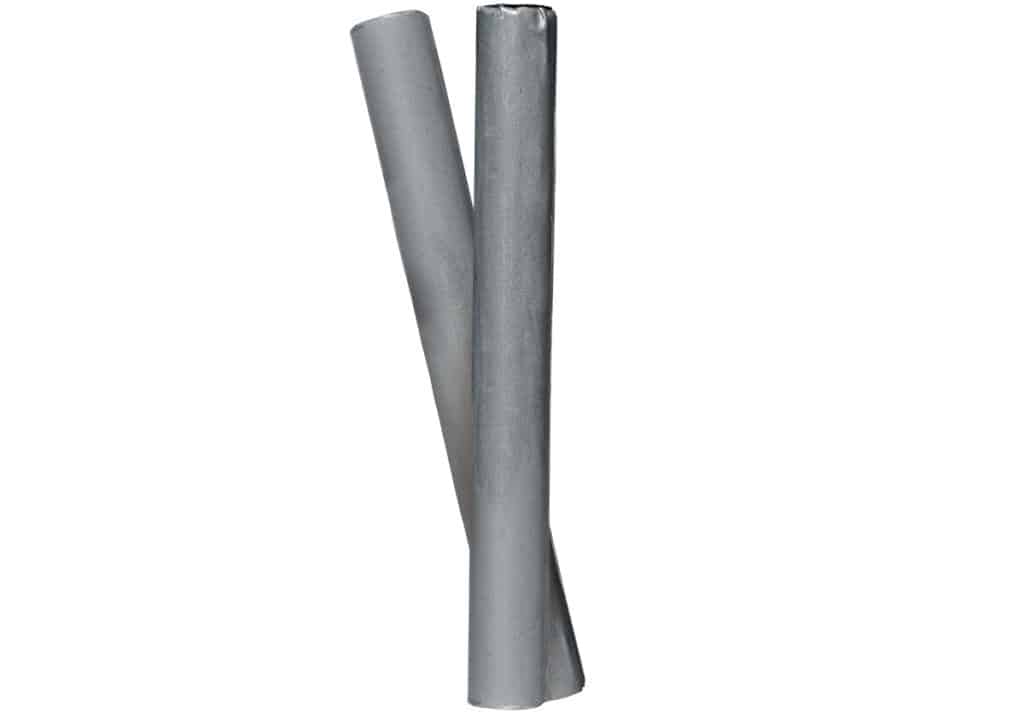
$24.99; westmarine.com The hardener is in the core of the putty stick, and the aluminum/resin mix is in the sheath. It’s ideal for metal-to-metal repairs, like leaking aluminum boat rivets. It took only a minute to knead it to readiness, and it could be easily applied under water. Cure Time: One hour Repair Notes: This was the easiest material we worked with. Break off a piece and knead it until it’s a consistent gray color. The directions say it can be applied and cured under water. Results: Latex gloves are still useful because the resin can adhere to skin as it is blended. We bonded a wet fitting, molded the material around the crack, and cured it under water. Connectivity: 3
Watertight: 3
Breaking Strength: 3
Ease of Use: 3 Total: 12 Bill Doster
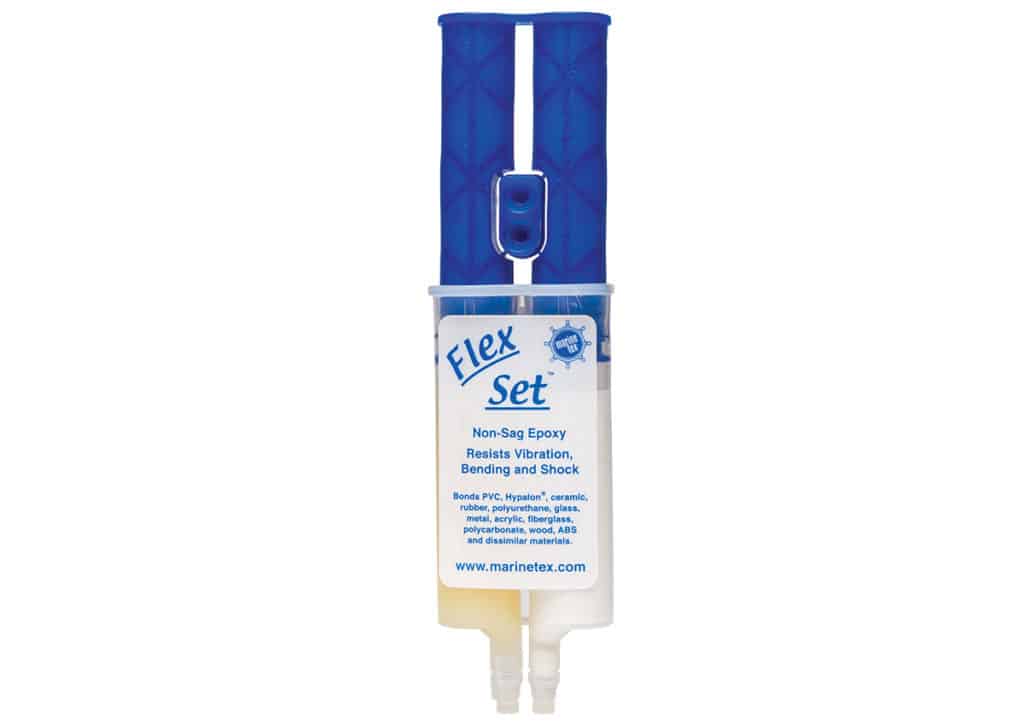
$28; marinetex.com It remains flexible after curing, is waterproof and cures in water. It expands to fill gaps and is sandable. Its cured color is white and, according to the spec sheets, there’s nothing it won’t stick to. It’s touted to bond dissimilar materials, like plastic to copper. Cure Time: One to two hours Repair Notes: It was the messiest to work with. Its curing time required clamping, but the bond appears strong. Excess glue chipped off with a fingernail for a tidier repair. Results: We liked its flexibility, but found it messy to use. The cap didn’t easily snap on the plunger nozzles for storage. Our feeling is the product is as strong as J-B Weld’s, but it should be, considering the price differential. Connectivity: 3
Watertight: 3
Breaking Strength: 3
Ease of Use: 2 Total: 11 Bill Doster
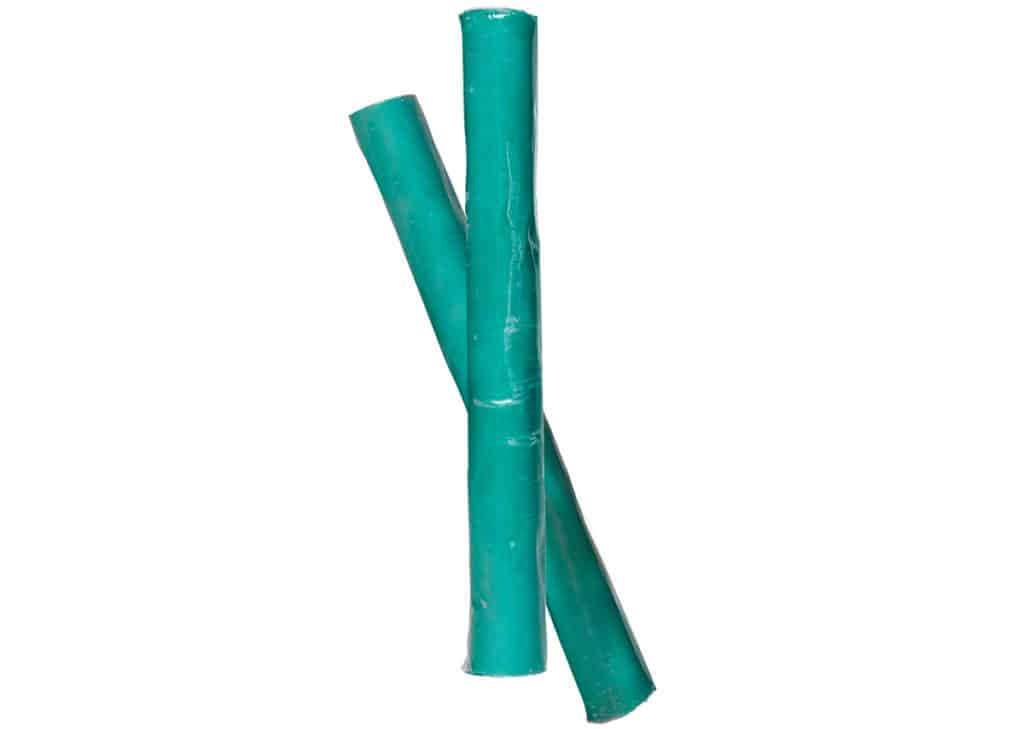
$24.99; westmarine.com The resin of this putty was wrapped around the hardener. It is designed to be applied above or below the waterline and can cure fully when submerged. Like the metal putty, it was simple to work with, but rubber gloves are a great idea. Cure Time: One hour Repair Notes: We broke off a gumball-size chunk of the two-part resin/hardener putty and kneaded it until it turned white — the color of the hardener inside the resin sheath. It was a simple matter to mold it around our broken fitting, and we tossed it in water to cure. Results: This could be a quick cure for a hole in a fiberglass boat and a real trip saver. Since we applied it to a wet surface and cured it under water, we have no doubt that it lives up to its hype. Connectivity: 3
Watertight: 3
Breaking Strength: 3
Ease of Use: 3 Total: 12 Bill Doster
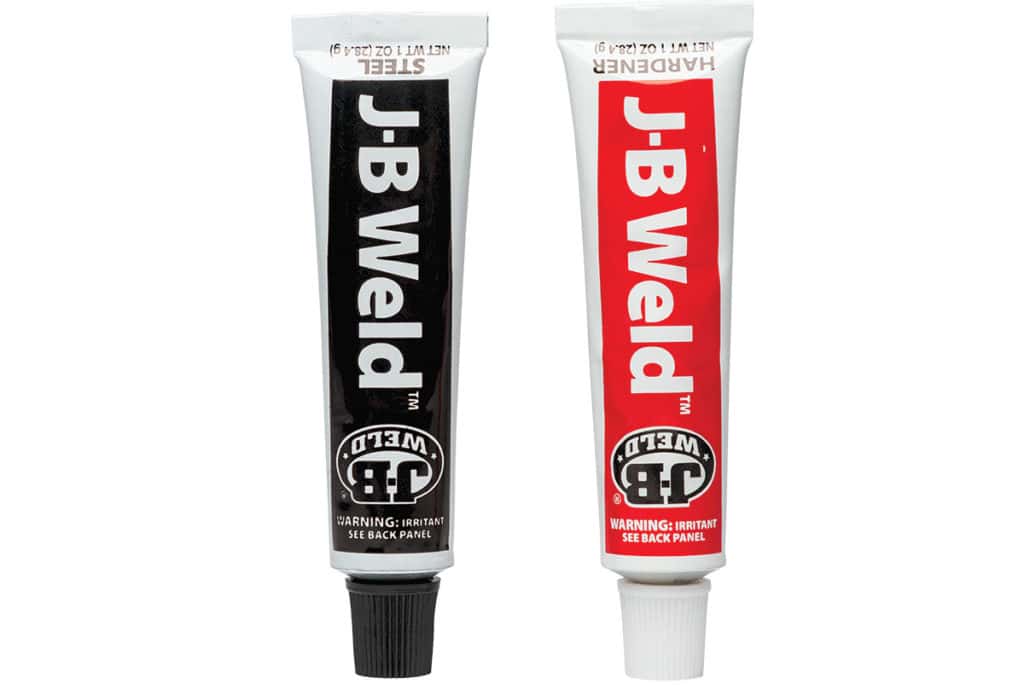
$7.99; jbweld.com Most boaters we know have this blend of resin and metal filings in their workshops. It is one of only three products we tested that promoted its tensile strength: 3960 psi. A faster-curing product boasts about half that strength. Cure Time: Four to five hours, maximum strength in 15 hours Repair Notes: Degrease with detergent and roughen surfaces with sandpaper. We conducted one extra test on it, joining two wire shafts together to simulate, say, splicing a broken throttle linkage. Results: We weren’t surprised at the great result. The epoxy flows nicely too, giving a less offensive repair than most. Because metal is its specialty, we spliced two coat hangers and found we could bend them without separating the bond. Connectivity: 3
Watertight: 3
Breaking Strength: 3
Ease of Use: 2 Total: 11 Bill Doster
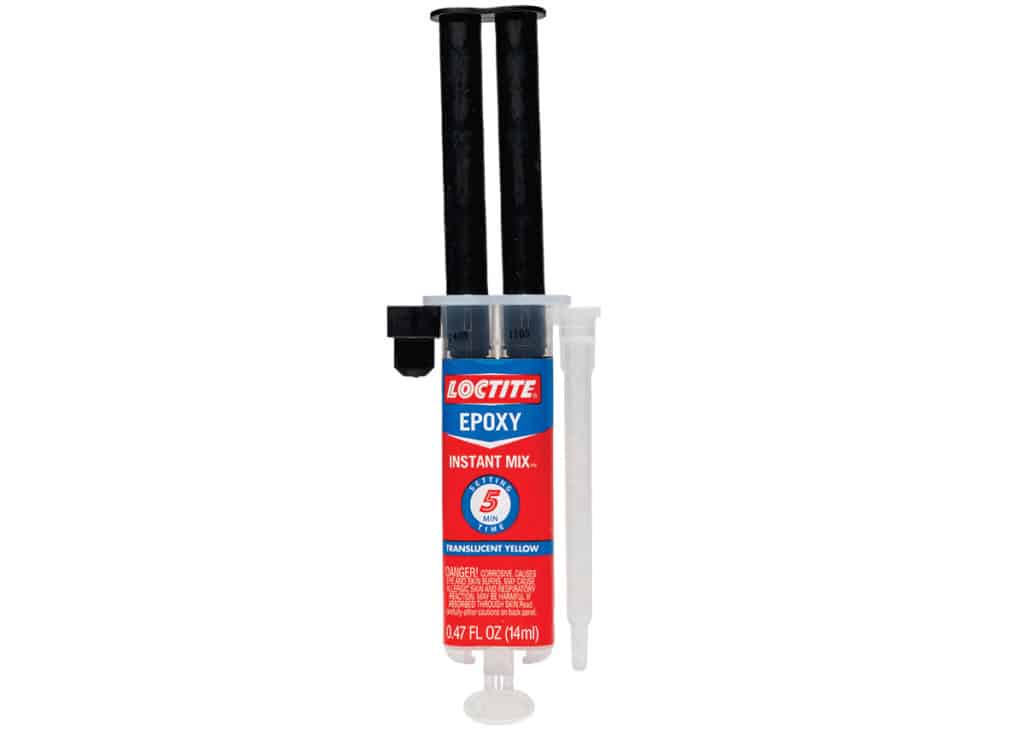
$5.99; loctiteproducts.com This was one of the easiest to work with. The included mixing nozzle eliminated the need to blend and apply the glue with a putty knife. It boasts a 3200 psi strength and can be colored with earth pigments, making it ideal to fix cracks or gaps in trim, teak soles or dash panels. The price includes two dispensers and mixing nozzles. Cure Time: Five minutes Repair Notes: The water-resistant bond isn’t intended for long-term immersion. The product cured quickly enough in our fingers and was solid enough to use in less than an hour. It gave us one of our tidiest repairs. Results: You can squirt it directly onto the repair surface from the dispenser/mixer. It was the easiest to use but had a slow leak in our pressure test. Connectivity: 3
Watertight: 2
Breaking Strength: 3
Ease of Use: 3 Total: 11 Bill Doster
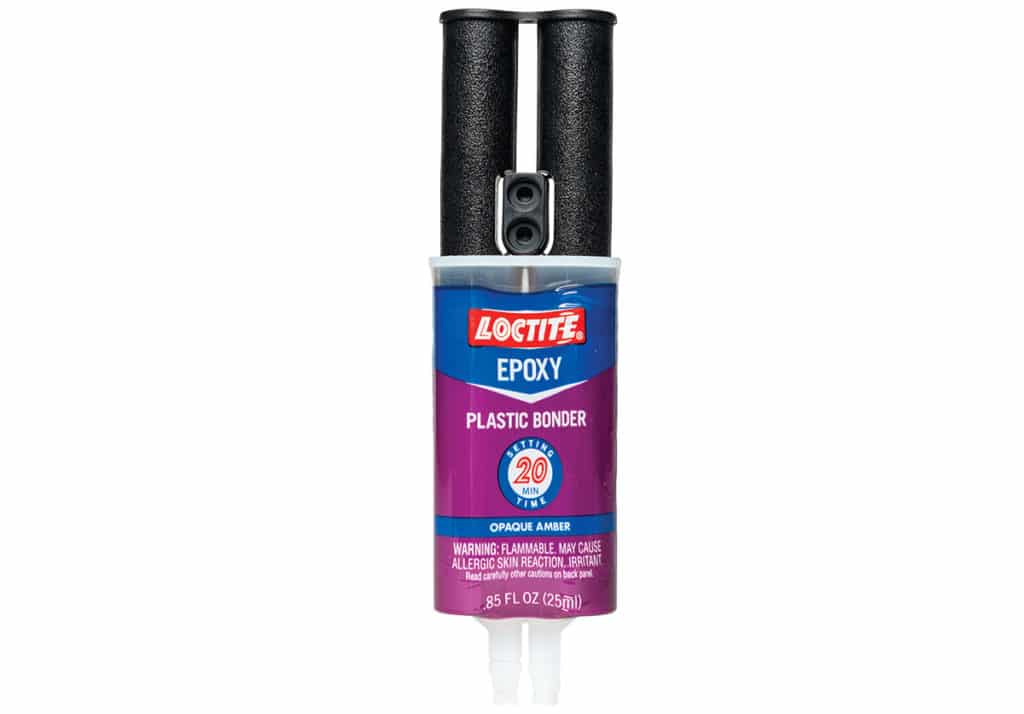
$5; loctiteproducts.com Loctite reports the glue’s bond strength is 3450 psi — a claim similar to J-B Weld’s. It is water resistant, but not waterproof or suitable for submersion. It repaired our fitting well, but it’s better suited for a fitting or other repair above the waterline. It cures in 20 minutes and bonds all forms of plastic. Cure Time: 20 minutes Repair Notes: The tube should be stored standing up for several hours prior to use to allow air bubbles to bleed to the top so they can be purged to ensure equal dispensing of resin and hardener. Results: It cured with a waxy appearance. We could chip off excess with a thumbnail, improving the look of the repair, and clear the barb and threads of errant glue. Its thickness could be beneficial in filling cracks in teak or mahogany. Connectivity: 3
Watertight: 3
Breaking Strength: 3
Ease of Use: 2 Total: 11 Bill Doster
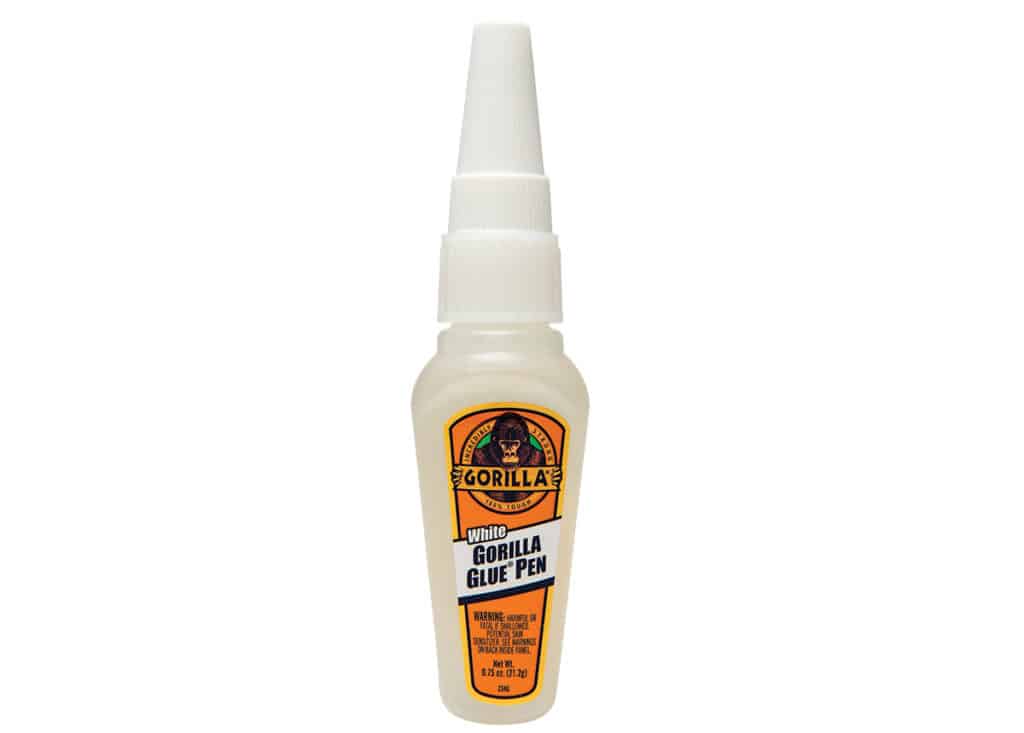
$9; gorillatough.com Dampen, glue and clamp. We did so. The product comes in a simple, stubby pen-shaped dispenser for easy use. It’s touted as waterproof, and the label says it dries white. Cure Time: 30 to 60 minutes Repair Notes: Our gray plastic fitting cured with no squeeze out, and the crack was nearly invisible. There was no sign of the white glue in our finished repair. The pen tube applied the exact amount of glue we needed. Results: This glue pen was the better of the two “instant” glues and easy to dispense. The repair was nearly invisible to the naked eye, but it leaked too much water, making it unsuitable for underwater use, in our opinion, and it also failed at only 5 pounds of weight. Connectivity: 3
Watertight: 1
Breaking Strength: 2
Ease of Use: 3 Total: 9 Bill Doster








